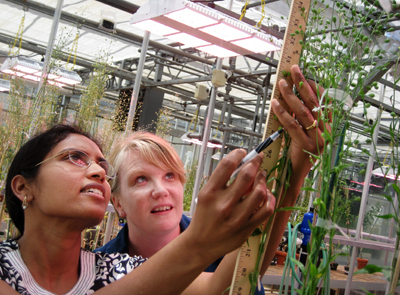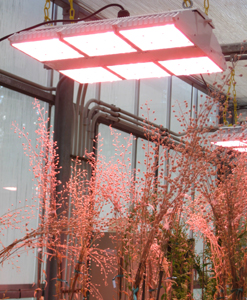
In an unassuming greenhouse along Method Road, NC State researchers are developing a new type of Camelina sativa plant that could change the way U.S. military jets are fueled. And thanks to a new collaboration between the research team and NC State’s Energy Management, these promising plants are growing beneath some of the most energy-efficient greenhouse lights in the nation.
Since camelina – which researchers are adapting for use as jet biofuel – only grows in colder climates, the research greenhouse must be cooled to the plant’s optimal growing temperature. With high summer heat and 1,000-watt greenhouse lights that simulated the sun’s rays, that cooling took a lot of energy – and money. Now, new LED lamps light the plants with just 35 percent of the energy consumed by traditional metal halide lamps.
“The old lights were hot – just poured out heat. The new lights are much more efficient and so cool,” said greenhouse technician Jennifer Swift. “It’s a huge reduction in energy and heat.”
Similar to a research-related rebate program done last year with ultra-low temperature freezers on campus, Energy Management funded half of the lights’ cost as an investment in future energy savings. In addition to lower maintenance costs, the new VividGro lamps are expected to reduce annual lighting costs by $1,600 and air conditioning usage by at least 15 percent.

“This project was a win-win for both research and energy consumption on campus,” said energy program coordinator Claudia Powell.
Specially designed to maximize plant growth, the lamps radiate no heat and are optically balanced so each plant in the row receives an equal amount of light.
“The light output is great. The plants love it,” said research project coordinator Maria Rodriguez-Welsh.
This Department of Energy-funded PETRO (Plants Engineered to Replace Oil) project will continue over the next 18 months as plant biologists – led by principle investigator Dr. Heike Sederoff – work to adapt camelina to tolerate the stress of heat and excess light while also producing greater yields necessary to meet demand for jet biofuel. In the future, N.C. farmers may be able to grow this resilient plant “on unused land that’s too dry or too low in nutrients” for food-producing crops, Rodriguez-Welsh said.